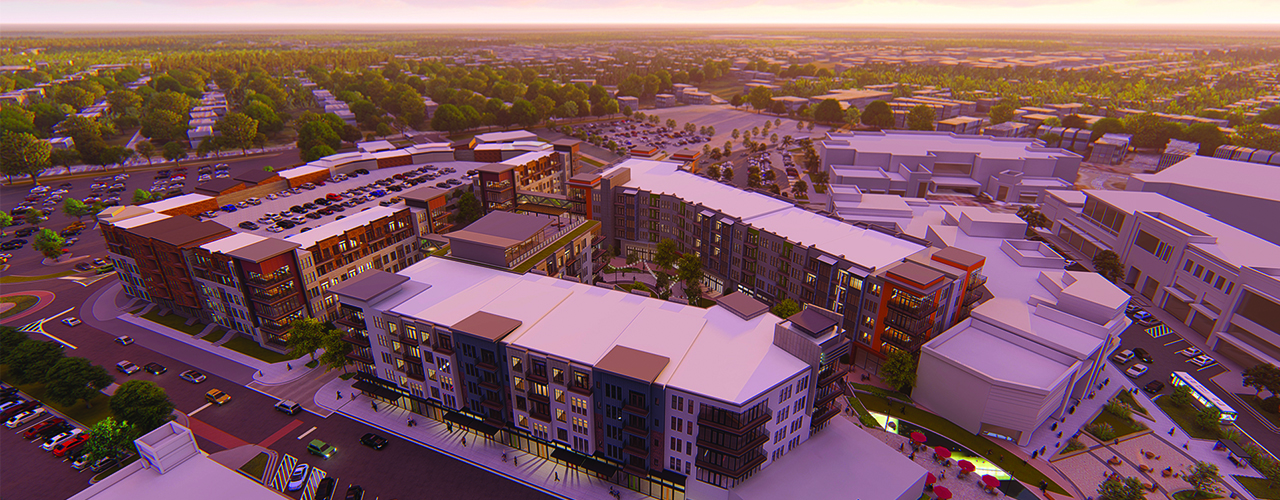BLOG
What Exactly Does Mixed-Use Mean?

Despite modern thinking, the concept of mixed-use isn’t modern at all. In fact, this is how communities, both organic and planned, have been structured since the dawn of civilization. The simple limitation of traveling distance required business, residential, civic and leisure functions to be located adjacent to each other.
In the short century since the introduction of the automobile, we’ve abandoned much hard-earned knowledge about how to best build resilient, thriving communities. However, recent years have witnessed a revival of interest in mixed-use by citizens, designers, local governments and developers alike.
By now, it’s well understood that this traditional paradigm does indeed foster richer, more vibrant and more desirable communities in ways that benefit stakeholders across the community.
At its core, mixed-use is the integration of residential spaces with other uses. People naturally feel a sense of ownership for the places in which they live, and this sense of responsibility and pride translates to the necessary investment, care and self-governance that forms the basis of neighborhood living.
This ownership mentality is a sturdy base for local business, and it improves buy-in for funding public infrastructure and amenities. The “live, work, play” concept is more than just a marketing trope; it’s how we spend most of our lives. The interactions forming the basis of our communities occur when these modes overlap and intersect.
Mixed-use works best when it embraces and encourages complexity in the functions that accompany the residential core. Simply put, communities thrive when many different uses and variables are at play adjacently—and simultaneously.
What does this look like in the real world? It could be a healthy retail mix that doesn’t lean too heavily on large anchor tenants. It could also describe a live/work environment with offices, restaurants and daytime amenities with extended business hours.
Most fundamentally, however, it recognizes the diversity of age, culture, and activity that is universally found in the most vibrant and resilient communities.
While it is critical to respect the timeless relevance of the mixed-use concept, we also must stay abreast of the latest industry trends. We must recognize emerging market and cultural forces and guide them with an inherited roadmap of best practices.
Here’s an example of the current situation. The millennial generation’s housing habits and opportunities are very different from those of the previous generations’ homeowners.
While much has been made of the millennials’ cultural acceptance of denser urban lifestyles, does this mean that they are uninterested in becoming homeowners? Record amounts of debt and a lack of entry-level housing stock are certainly critical factors in this case.
Designers must understand which aspects of home-making millennials eschew, and which ones they embrace, especially when cost isn’t a factor. The next step is to help this upcoming generation of leaders and business owners invest meaningfully in their own communities.
At the other end of the spectrum, many empty nesters are downsizing after a lifetime of traditional home ownership. Studies have repeatedly shown that people live longer, stay healthier and have higher quality of life when they are physically active and participate in vibrant communities. Seniors who can walk to services tend to live fuller, richer lives and are more likely to maintain their health and vitality. Many choose new living arrangements to maintain their independence and mobility, making them an ideal demographic for mixed-use development.
Mixed-use is not a trend, but rather a fundamental axiom of healthy communities—the very sort of communities that support thriving businesses and people. By continuing to educate, design and encourage the return to mixed-use principles, we invest not only in our clients, but also in our own corporate citizenship.

Tony Martin, RA
With nearly three decades of experience in architectural design, Tony has produced award-winning designs across the full spectrum of commercial and institutional building sectors. He is a creative, big-picture thinker who strives to create peak design outcomes, yet he maintains a practical perspective well-grounded in reality and experience.

Will Tufts
Will Tufts is an architectural designer with experience in master planning, architecture, energy modeling, and 3D rendering and animation. His projects have ranged from aesthetic design and programming studies to conceptual design leadership for large mixed-use and military projects.